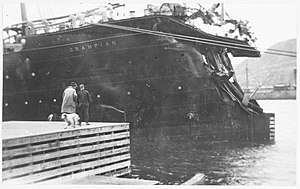SS Grampian
SS Grampian was a ship built by the Scottish shipbuilding company, Stephen & Sons Ltd., in 1907. In 1919 it struck an iceberg but was able to make its way back to port. In 1921, during a refit in Antwerp, the ship was gutted by a fire and abandoned to its insurance underwriters. She was sold for scrap in 1925.
 SS Grampian after hitting an iceberg on July 10, 1919 | |
| History | |
|---|---|
| Name: | SS Grampian |
| Owner: | Allan Line Royal Mail Steamers |
| Builder: | Stephen & Sons Ltd. |
| Completed: | 1907 |
| History | |
| Name: | SS Grampian |
| Owner: | Canadian Pacific Steamships |
| Route: |
|
| Builder: | Stephen & Sons Ltd. |
| Fate: | Gutted by fire at Antwerp during refit in 1921, abandoned to underwriters. Sold for scrap in 1925.[2] |
| General characteristics | |
| Type: | Ocean liner |
| Displacement: | 10,947 tons[3] |
| Length: | 148 m (486 ft) |
| Beam: | 18.3 m (60 ft) |
| Installed power: | 802 n.h.p. |
| Propulsion: | triple expansion engines 2× screws |
| Speed: | 15 knots (28 km/h; 17 mph) |
Career
In 1907, Sir Montagu Allan of Allan Line Royal Mail Steamers ordered the Grampian from the Stephen & Sons Ltd. building yards, as the company was expanding and had just added offices in Boston and London. In 1917, Sir Montagu Allan, who represented the third generation of the Allan family, sold the family company to Canadian Pacific Steamships (CP Ships). It was not long before the Allan name had disappeared from commercial shipping.[4]
During World War I, the Grampian was used as a troop transport ferrying soldiers of the Canadian Expeditionary Force (CEF) from Canada to the war in Europe. In between ferrying the CEF, she did commercial work.[5]
Iceberg strike
During the summer of 1919, Grampian was on her way from Montreal to Liverpool, with 750 passengers and a crew of 350.[6] Of the passengers, 500 were women and children.[7] On July 10, 1919, the ship struck an iceberg off Cape Race on the southeastern tip of Dominion of Newfoundland.
The crash was very similar to the collision of the RMS Titanic with an iceberg seven years before. However, Grampian was spared the Titanic's fate as the iceberg did not strike the side of the ship, as had happened with the Titanic. The decision to hit the iceberg head-on was a conscious choice by the captain, who knew the dangers of an iceberg slicing open the ship's metal plating. When the iceberg was sighted, the captain realized he could not avoid it and so decided to hit it squarely in the bow.[6] The ship was traveling slowly at the time. Even with the slow speed, the front of the ship was crushed. Grampian was not damaged below its waterline and was able to steam to port in St. John's, Newfoundland.[6] Passengers in the smoking-room reported that the impact was slight and they were not even thrown from their seats.[6] Two men working in the forward part of the ship were killed, and two were injured during the collision.[6]
Fire
While undergoing a refit in Antwerp in 1921, the ship was gutted by a fire and sank in 30 feet (9.1 m) of water. Adjusters deemed the ship a write-off and abandoned it to the insurance underwriters. She was sold for scrap in 1925.[2]
See also
| Wikimedia Commons has media related to SS Grampian (1907). |
Bibliography
Notes
- Simpson 2017, p. 294
- Canadian Railway and Marine World 1921, p. 618
- Pablobini 2010
- Brado 2004, p. 98.
- Oldfield 2016, p. 462.
- New-York Tribune 1919, p. 1
- The Evening World 1919, p. 1
References
- Brado, Edward (2004). Cattle Kingdom: Early Ranching in Alberta. Heritage House Publishing Co. ISBN 978-1-894384-57-5.CS1 maint: ref=harv (link) – Total pages: 288
- Canadian Railway and Marine World (1921). "Canadian Railway and Marine World". Canadian Railway and Marine World. Toronto. vol. 24. ISSN 0319-437X.CS1 maint: ref=harv (link)
- The Evening World (July 10, 1919). "Liner with 1,100 aboard smashes bow on iceberg to avert a Titanic disaster" (Daily Broadsheet). The Evening World. New York, N.Y.: Joseph Pulitzer. ISSN 1941-0654. OCLC 9368601. Retrieved July 16, 2019.CS1 maint: ref=harv (link)
- New-York Tribune (July 11, 1919). "Skipper saves big liner from Titanic's fate". New-York Tribune. ISSN 1941-0646. OCLC 9405688. Retrieved July 16, 2019.CS1 maint: ref=harv (link)
- Oldfield, Paul (2016). Victoria Crosses on the Western Front – 1917 to Third Ypres: 27 January – 27 July 1917. Pen and Sword. ISBN 978-1-4738-8489-2.CS1 maint: ref=harv (link) - Total pages: 576
- Pablobini (November 11, 2010). "SS Grampian (+1921)". Wrecksite. Retrieved July 16, 2019.CS1 maint: ref=harv (link)
- Simpson, Paul W (2017). Windjammer. Lulu.com. ISBN 978-0-244-90911-6.CS1 maint: ref=harv (link) – Total pages: 452